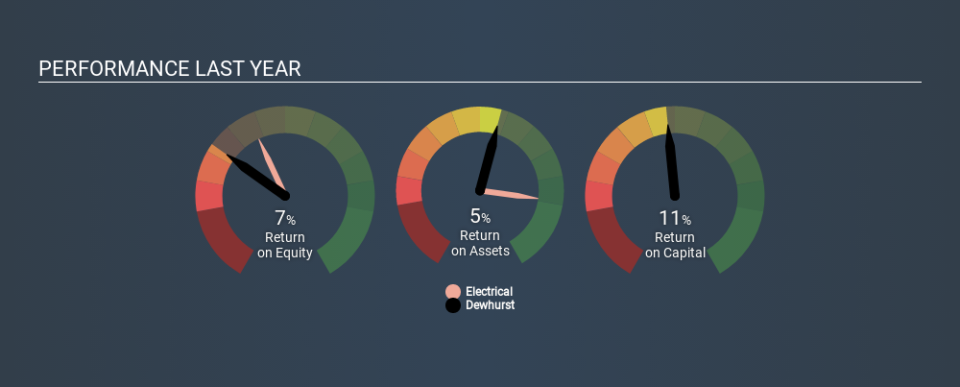Is Dewhurst PLC (LON:DWHT) Struggling With Its 11% Return On Capital Employed?

Today we are going to look at Dewhurst PLC (LON:DWHT) to see whether it might be an attractive investment prospect. Specifically, we'll consider its Return On Capital Employed (ROCE), since that will give us an insight into how efficiently the business can generate profits from the capital it requires.
First, we'll go over how we calculate ROCE. Next, we'll compare it to others in its industry. Finally, we'll look at how its current liabilities affect its ROCE.
Return On Capital Employed (ROCE): What is it?
ROCE is a metric for evaluating how much pre-tax income (in percentage terms) a company earns on the capital invested in its business. All else being equal, a better business will have a higher ROCE. Overall, it is a valuable metric that has its flaws. Author Edwin Whiting says to be careful when comparing the ROCE of different businesses, since 'No two businesses are exactly alike.
So, How Do We Calculate ROCE?
Analysts use this formula to calculate return on capital employed:
Return on Capital Employed = Earnings Before Interest and Tax (EBIT) ÷ (Total Assets - Current Liabilities)
Or for Dewhurst:
0.11 = UK£6.0m ÷ (UK£62m - UK£8.7m) (Based on the trailing twelve months to September 2019.)
So, Dewhurst has an ROCE of 11%.
Check out our latest analysis for Dewhurst
Is Dewhurst's ROCE Good?
One way to assess ROCE is to compare similar companies. We can see Dewhurst's ROCE is meaningfully below the Electrical industry average of 14%. This could be seen as a negative, as it suggests some competitors may be employing their capital more efficiently. Separate from Dewhurst's performance relative to its industry, its ROCE in absolute terms looks satisfactory, and it may be worth researching in more depth.
You can see in the image below how Dewhurst's ROCE compares to its industry. Click to see more on past growth.
Remember that this metric is backwards looking - it shows what has happened in the past, and does not accurately predict the future. ROCE can be misleading for companies in cyclical industries, with returns looking impressive during the boom times, but very weak during the busts. ROCE is only a point-in-time measure. Since the future is so important for investors, you should check out our free report on analyst forecasts for Dewhurst.
Do Dewhurst's Current Liabilities Skew Its ROCE?
Liabilities, such as supplier bills and bank overdrafts, are referred to as current liabilities if they need to be paid within 12 months. The ROCE equation subtracts current liabilities from capital employed, so a company with a lot of current liabilities appears to have less capital employed, and a higher ROCE than otherwise. To check the impact of this, we calculate if a company has high current liabilities relative to its total assets.
Dewhurst has total liabilities of UK£8.7m and total assets of UK£62m. As a result, its current liabilities are equal to approximately 14% of its total assets. A fairly low level of current liabilities is not influencing the ROCE too much.
What We Can Learn From Dewhurst's ROCE
This is good to see, and with a sound ROCE, Dewhurst could be worth a closer look. There might be better investments than Dewhurst out there, but you will have to work hard to find them . These promising businesses with rapidly growing earnings might be right up your alley.
If you are like me, then you will not want to miss this free list of growing companies that insiders are buying.
If you spot an error that warrants correction, please contact the editor at editorial-team@simplywallst.com. This article by Simply Wall St is general in nature. It does not constitute a recommendation to buy or sell any stock, and does not take account of your objectives, or your financial situation. Simply Wall St has no position in the stocks mentioned.
We aim to bring you long-term focused research analysis driven by fundamental data. Note that our analysis may not factor in the latest price-sensitive company announcements or qualitative material. Thank you for reading.

 Yahoo Finance
Yahoo Finance 
